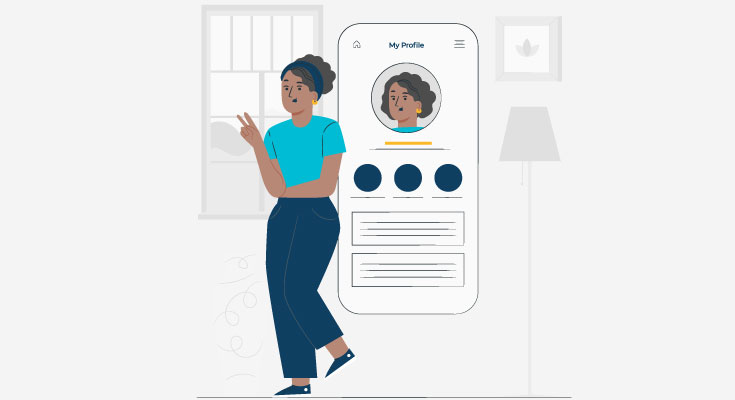The world has gone digital. Work, food, education, entertainment, or everything else you can think of has become completely digital. Your digital identity plays a vital role in how your experiences will be online. If you don’t follow the right measures, hackers can get access to your digital identity. Your digital ID can be sold on the dark web for a couple of dollars. So, what can you do to stay safe online? Before we dive deeper into the concept of digital ID, and how it is slowly changing the way we operate online, let’s try to understand Digital identities.
What is a Digital Identity?
A digital identity is online data that’s connected to an individual, a business, or any entity. This information can be anything ranging from social media posts, banking information, usernames, passwords, or more. Hackers work around the clock to get access to this sensitive information.
Traditionally, proof of identity is something all of us provide to prove we are who we claim to be. Proof of identity is required for a number of reasons. However, when it comes to digital identity, the term is used for digital data or digital interactions.
In both versions of identity, one factor is common. Any version of identity uses credentials and data to identify ourselves, and access products and services. Both traditional identity and digital identity allow users to prove who they are and then access resources.
At its core, your digital identity is a web of information. Your Digital ID information can include aspects, information, and credentials. Any information that helps you verify your identity, is part of your Digital identity.
For a social media user, their digital identity would include:
- Personal information (Name, DOB, and more as asked by the platform)
- Login credentials (usernames, passwords, and biometric data)
- Any additional information related to user behavior on-site (user permission, subscriptions, connections, settings, etc)
Components of Digital Identity
If you want, you can easily break down digital identities into two primary components:
- Attributes: Attribute is the information that’s related to your representation in the system. This information includes personally identifiable information (PII) such as ID number, payment details, login credentials, and more
- Activities: Activities are a record of what you’re doing as a user. All the activities you do become a part of your identity. It can be something as simple as reading comments or posting online. In government environments, these activities include digital signatures, search queries, or legal activities.
As the world is continuously evolving about digital identity, it makes sense that digital identity data is leveraged to verify identity data.
Challenges and Risk Revolving Around Digital Identity
While there are endless benefits of having a digital identity, they’re also at most risk of getting hacked or stolen. If you’re also concerned about the risk of digital identity verification.
Businesses and other institutions face a lot of challenges while managing digital identities. Here are all the risks of digital identities:
1. Security and Privacy
The biggest question around digital identity data is security. If you have any kind of business, you have to rely on identification and authentication services to protect your systems and the identifying information of your customers and employees.
2. Regulatory Compliance
Many forms of digital ID also include some type of sensitive data. A user in a healthcare portal will have a corresponding ID that includes protected information under HIPAA.
3. Ownership and Ethical Handling
Recent data collection processes, especially in the United States, haven’t emphasized user ownership of digital identities. Companies can collect and sell user data as per their preference.
The question of ownership of data and ethical management and use of digital ID is a huge question. Modern compliance frameworks like GDPR and CCPA are attempting to improve the data handling for users.
4. Fraud
Proving who a user claims to be is crucial for businesses. Without proper measures in place, businesses can end up onboarding fraudsters that look like real users. A hacker can easily use a digital identity for harmful purposes if they want.
Global Impact of the Use of Digital Identities
The above-mentioned challenges are ever-present in the modern digital ID landscape. Digital identities are becoming more crucial for having a proper online experience. Here are some of the recent trends that have come from the use of digital Identity:
- Modern smartphones have made using digital forms of payment much easier. There is a push in the UK, and the United States to expand the use of this technology.
- A major discussion point during the ID2020 summit in New York was for the UN to start considering the potential of blockchain technology. The reliance on digital marketing technology can support universal forms of digital ID verification.
- Germany has been circulating E-versions of ID cards for their citizens. While these don’t replace physical IDs, they are used in multiple locations and provide a better online experience.
- Canada is also making plans to roll out its digital ID scheme known as the Pan-Canadian Trust Framework to provide national digital IDs and unified logins.
Conclusion – Understanding Digital Identity
Now that digital identity is about to become an industry standard, verification and authentication of digital identity are becoming crucial. ID management solutions are helping in reducing the challenges in digital ID management.
Proper adoption of Digital ID can lead to more innovation in several industries. Verifying and authenticating digital Identities is the need of the hour. This can be achieved via online document verification solutions.





